Research Article - (2023) Volume 12, Issue 1
Background and objectives: Traditional veterinary knowledge is the native knowledge of traditional livestock breeding in different regions. In this study, we examined the indigenous knowledge of the people of a village in Kerman Province, on the treatment of livestock diseases.
Aim of the study: The aim of the study was too reported and documents this traditional veterinary knowledge and share with the community.
Methods: This study was conducted from October-2019 to October-2020 in Mehrabad a village near Shahrbabak, Province Kerman in Iran. First, questionnaires were designed to identify the traditional treatments for livestock diseases in Mehrabad and then were giving among 11 people (three women and eight men) who were traditional livestock breeders aged 60–85 years old. Meanwhile, botanical samples of the region’s plants were collected, and the data on therapeutic effects were supplemented by information include scientific name, family name, local name, parts used, habit, preparation, uses and mode of application.
Results: After reviewing the data on 23 livestock diseases in the region, 37 species of medicinal plants belonging to various 25 families were found to be used in traditional treatments used by the villagers. The highest number of species was recorded belonged to the family Apiaceae. Major plant parts used were seeds (23%) and 72% of the reported species are the herb. The main method of drug use is oral (72%).
Conclusion: The information was obtained in this study may help in uses and discovery of new drugs and further studies are needed to prevent the extinction of traditional veterinary knowledge (ethnoveterinary).
Ethnoveterinary • Medicinal plants • Indigenous knowledge • Livestock • Iran
Indigenous Technical Knowledge (ITK) that over time mainly in society Through the experiences and an understanding of the environment In a particular culture, developed and has been transferred from generation to generation understanding indigenous knowledge in agriculture helps to ensure that incorrect agricultural practices lead to erosion and degradation of the environment. In fact, this knowledge is essential for sustainable food security, the protection of the diversity of plant and animal species, and the vital properties of the soil, such as physical, biological and chemical properties. Conservation depends on human beings and their interaction with the environment that is highly relevant to understanding indigenous knowledge [1-6].
Traditional veterinary is one of the legitimate and scientific traditional methods that have been used among different ethnic since ancient times. Today, the science of the use of medicinal plants, And the application of traditional methods for health and treatment of sick livestock are generally called traditional veterinary or Ethno veterinary.
Traditional veterinary knowledge is the native knowledge of traditional livestock breeding in different regions, and this knowledge and expertise are unique to their own livestock diseases, including the use of natural ingredients, herbs and living beings. It can be argued that a large part of traditional medicine originated from observations and experiments on medicinal plants, and in this regard, the behavior of animals has been considered by some plants and their instinctive use in the treatment of diseases. There is a shortage of veterinarians, low and indirect supply of veterinary medicines, high costs of equipment and drugs, and the side effects of chemical drugs (both on the livestock and on humans as a consumer of livestock products), and on the other hand the risk Extinction threatens local indigenous knowledge of ethno-tourism, so it's time to pay more attention to this indigenous knowledge in our country. According to the World Health Organization, about 80% of people in developing countries use traditional herbal medicines to treat animals [7-12].
Native herders who are deployed in many countries use their indigenous knowledge. This knowledge has been gained through cultural communication, experiments, and experimental observations over the years, and if written, can be used as a way to transfer the use of medicinal herbs. In a veterinarian that has been tried and used by local people for generations. In developing countries, animal husbandry and the presence of animals play a very important role in the lives of farmers in rural communities and represent a great asset for farmers owning small lands. These farmers are located in remote areas for transport, meat; milk and skin production are economically dependent on their livestock. In these areas, naturally, livestock are also affected by various factors, and livestock farmers treat traditional herbal medicines in their livestock. In some cases, the organ of the plant is used alone by the livestock, and at other times many diseases of the livestock are treated with several medicinal plants. In ancient times, traditional drugs were used to treat livestock, but later it gave his place to chemical drugs. Nowadays, due to the high cost of chemical drugs and the complications of these drugs, as well as the potential of Shahrbabak city to promote the knowledge of ethno veterinary in this region, this native study is required. In this research, halfstructured questionnaires are design and interviewed with local people by referring to rural and mountainous areas, The plants are collected and identified each herbarium sample is prepared and the results are included in a table for the use and registration of this indigenous knowledge. The main aim of this study was to release the knowledge of traditional veterinary by sharing with community members of district Shahrbabak, Mehrabad village.
Study areas
A survey of ethno veterinary medicinal plants in Mehrabad village, Shahrbabak district, Kerman was carried out between October-2019 to October-2020. Shahrbabak district is bounded on the north by Mehriz district, on the east by Rafsanjan district, on the south by Sirjan district and on the west by Khatam district. Shahrbabak is located 240 km from Kerman. Mehrabad village located 15 km southwest of Shahrbabak Based on the latest statistics obtained from the Health Care Home of Mehrabad, a total of 124 focal and extended families (a population of 488 people) lived in the village in 2010. In total, the region’s income generating activities include crop activities, livestock breeding, and to a much lesser extent handicraft activities. The district lies 55’12 north latitudes and 30’11 east longitudes. The altitude of the Mehrabad is ranging from 1700-2000 meters above sea level and average annual temperature ranges 15.5°C, the area is dominated by indigenous plants. Mixed crop and livestock farming system is the mode of agriculture in the Mehrabad [14-20].
Investigating methods
An ethno-veterinary botanical survey was conducted to congregate information on the traditional uses of plants in animals such as goat and sheep and human health care system using a semi-structured interview and observation with the traditional healers who were willing to share to their indigenous knowledge many extensive trips such as goat and sheep were undertaken between 2019 and 2020 in different seasons for the collection of plants and associated ethno medicinal information from the Shahrbabak villages.
Data collection
Specimens of plants that were used by the traditional healers for treatment of livestock and human ailments were collected. The collection data were based on the information supplied by the healers during the interview. The specimens of plants were collected in the field using standard botanic methods together with the traditional livestock, that including the vegetative part, leaves, floral, fruit and seed, parts as it was appropriate for taxonomic identification. During collection information regarding, habitat data, general description of the plant and geographical site of collection were recorded. The information collected included the local name of the traditional medicinal plant, diseases treated, parts used, condition of the plant used, method of preparation and route of administration.
The collected samples of medicinal plants were coded, pressed, and dried then taken to botanical identification by botany specialists in Faculty of Pharmacy Kerman University of Medical Sciences Herbarium.
Data analysis
Statistical methods (Proportions, percentiles and tables) were used to summarize the collection of ethno-veterinary data.
Demographic characteristics of participants
A total of 11 traditional livestock breeders (3 women and eight men) of 60–85 years old and all of them were either illiterate or had a basic education in was purposively selected and interviewed based on their knowledge on traditional medicine using semi-structured interviews and field observatios. The information about the all plants was collected from different parts of the village district.
Diversity of medicinal plant species in the study area
A total of 37 ethno-veterinary medicinal plant species belonging to various 25 families were documented with details on their importance, scientific name and code, family name, local name, parts used, habit, preparation, used and mode of application (Table 1). Apiaceae (26%/ 31%), Papilionaceae (21%/05%), Lamiaceae (10%/53%), Liliaceae (10%/ 53%), Rosaceae (10%/53%) and Solanaceae (10%/53%) (Figure 1), and also Peganum harmala L. (12%/5%), Vitis vinifera L. (9%/37%), Allium cepa L. (9%/37%), Ricinus communis L. (9%/37%), Malva sylvestris L.(9%/37%) Trigonella foenum-graecum L., Elaeagnus angustifolia L. Foeniculum vulgare Miller, Chenopodium album L., Spinacia oleraceae, Teucrium polium L. and Artemisia sieberi each (6%/25%) (Figure 2). Have been the most frequently used and reported plant families and species for ethno-veterinary practices. one plant species to one disease, and mixing of two or more different medicinal plants against a single disease was also commonly observed, were the most frequently used and reported plant families and species for ethno-veterinary practices. Many plants were mentioned against particular diseases, one plant species to one disease.
| No | Scientific name and Code | Family name | Local name | Parts used | Habit | Preparation | Uses | Mode of application | |
|---|---|---|---|---|---|---|---|---|---|
| 1 | Achillea wilhelmsii C.Koch.(KF1155) | Apiaceae | Boomaderan | Aerial part | wild | Herb | Aerial part mixed with water and the sediment applied topically. | Wound | Topical |
| 2 | Alhagi persarum Adans.( KF 1621) | Papilionaceae | Kharshotor | Aerial part | wild | Herb | Aerial part are boiled in water and given to orally | Rumen impaction | Oral |
| 3 | Allium cepa L.(KF1670) | Liliaceae | Piyaz | Bulb | Bulbous herb | Crushed Bulb mixed with water given to orally | Coughing | Oral | |
| Bulbs are consumed by form of chewing | Bloating , Appetizing | Chew | |||||||
| 4 | Allium sativum L.(KF1669) | Liliaceae | Sir | Bulb | Bulbous | Bulb are squashed and filtered given to orally | Internal parasite | Oral | |
| 5 | Amygdalus communis L. | Rosaceae | Badam e shirin | Seeds | Tree | seed oil is orally administered | Rumen impaction | Oral | |
| 6 | Anethum graveolens L.( KF1137) | Apiaceae | Shavid | Fruit | Herb | Fruits are boiled in water then the filtered juice given to orally | diarrhea | Oral | |
| 7 | Artemisia sieberi Besser. ( KF1102) | Compositae | Jaz,Dermaneh | Aerial part | Herb | Aerial parts are boiled in water then the filtered juice given to orally | Internal parasite Digestive problems | Oral | |
| 8 | Cannabis sativa L.(KF1369) | Cannabinaceae | Shahdane | leaves | Shrub | Fresh leaves are crushed and applied topically | External Parasite | Topical | |
| 9 | Cassia fistula L. | Caesalpinaceae | Sena make | Leaves | Shrub | Leaves are boiled in water and given to orally | Rumen impaction | Oral | |
| 10 | Chenopodium album L.( KF1335) | Chenopodiaceae | Salme | Whole plants | Herb | The whole parts are consumed by form of chewing | Internal Parasite, Blood purifier | Chew | |
| The whole parts are boiled in water then the filtered juice given to orally | Laxative | Oral | |||||||
| 11 | Cuminum cyminum L. (KF1357) | Apiaceae | Zire sabz | Fruit | Herb | Decoction of whole plant is given to orally | gastric problem | Oral | |
| 12 | Discurainia Sophia (L.)Schur (KF 1209) | Cruciferae | Khakshir | Seeds | Herb | Seeds are boiled in water and given to orally | external | Oral | |
| 13 | Elaeagnus angustifolia L( KF 1317) | Elaeagnaceae | Senjed | Fruits | Tree | Fruits are powdered and given orally | diarrhea | Oral | |
| Stem bark | Tree | Broken organ will be closed by the stem bark | bone fracture | Topical | |||||
| 14 | Eucalyptus camaldulensis Var. | ?Myrtaceae | ocalyptus | Leaves | Tree | Fresh Leaves crushed and mixed with water and the extract given to orally | Antiseptic | Oral | |
| 15 | Foeniculum vulgare Miller. (KF1466) | Apiaceae | badian | Fruit, Aerial parts | Herb | seeds are crushed and powder is given to orally Aerial parts are boiled in water and are fed to the animal | Digestive problems diarrhea | Oral | |
| 16 | Glycerrhiza glabra L.( KF1273) | Papilionaceae | maki | Roots | Herb | Roots are boiled in water and given to orally | Diarrhea | Oral | |
| 17 | Juglans regia L.(KF1656) | Juglandaceae | Gerdoo | Leaves | Tree | Leaves are boiled in water then the filtered juice given to orally | External Parasite | Oral | |
| 18 | Malva sylvestris L.(KF1301) | Malvaceae | Khatmi | Aerial parts | Herb | Dried aerial parts are mixed with water given to orally | Fever, Coughing, cold | Oral | |
| 19 | Medicago sativa L.( KF 1272) | Papilionaceae | Yonje | Aerial part | Herb | Fresh Aerial part is fed to animal | General tonic,Enhancement of lactation | Chew | |
| 20 | Mentha longifolia (L.) Huds (KF1353) | Lamiaceae | Poodene | Leaves | Herb | Fresh or dried leave infusion is given orally | Digestive problems | Chew | |
| 21 | nicotiana tabacum L. | Solanaceae | tanbacco | Leaves | Herb | dried Leaves mixed with water and filtered given to orally | Internal parasite | Oral | |
| dried Leaves mixed with water and Is poured on the back of Gusev | External Parasite | external | |||||||
| 22 | Olea europaea L.( KF1434) | Oleaceae | Zytoon | Fruits | Shrub | Fruits oil is orally administered | Rumen impaction | Oral | |
| 23 | Papaver somniferum L.( KF1260) | Papaveraeae | Taryak | Fruits | Herb | Opium mixed with little water and applied topically | mastitis | topical | |
| 24 | Peganum harmala L.( KF 1296) | Zygophyllaceae | Esfand | Seed | Herb | Dried Seeds smoked | Mastitis, External Parasite, Wound, pain | smoke | |
| 25 | Pistacia atlantica L.(KF1136) | Anacardiaceae | Bane | Leaves | Plant | Dried leaves smoked( smoke bath) | Coughing | smoke | |
| 26 | Prangos cheilanthifolia Boiss.( KF 1181) | Apiaceae | jashir | Aerial part | Herb | Aerial parts are boiled in water and is applied on the skin | External Parasite | Topical | |
| 27 | Ricinus communis L.( KF 1398) | Euphorbiaceae | Karchak | Seeds | Shrub | seed oil is orally administered | Rumen impaction, Digestive problems | Oral | |
| Roots | Shrub | Root paste is given orally | Retained placenta | Oral | |||||
| 28 | Rosa damascena Mill.( KF 1362) | Rosaceae | Gholye mohamadi | Flawers | Shrub | Flowers are boiled in water and given to orally | Rumen impaction | Oral | |
| 29 | Solanum nigrum ( KF1305) | Solanaceae | Roopas | seeds | Herb | Dried Seeds are boiled in water and given to orally | Fever, Coughing, cold | Oral | |
| 30 | Spinacia oleraceae L. | Chenopodiaceae | Sfenaj | Leaves | Herb | Juice of leaves and given to orally | Antiseptic | Oral | |
| Chenopodiaceae | Sfenaj | Leaves | Herb | Fresh leaves crushed and squeezed and the juice is | Internal parasite | Oral | |||
| 31 | Tamarix aralensis Bge. (KF1365) | Tamaricaceae | gaz | Stem | Shrub | Dried Twigs smoked smoke bath the smoke of the branches is used | Retained placenta | smoke | |
| 32 | Teucrium polium L.(KF1249) | Lamiaceae | Kalpoure | Aerial part | Herb | The dried Aerial part mixed with water and filtered given to orally | Digestive problems, diarrhea | Oral | |
| 33 | Thea sinensis | Theaceae | Chay | Leaves | Shrub | The dried are boiled in water then the filtered juice given to orally | Off feeding | Oral | |
| 34 | Triticum aestivum L.(KF1677) | Geramineae | Gandom | Seeds | Herb | The seeds are roasted and given to orally | Enhancement of lactation | Oral | |
| 35 | Ttrigonella foenum-graecum L.(KF1523) | Papilionaceae | Shanbalile | Seeds | Herb | Seeds are boiled in water and given to orally | Diarrhea, mastitis | Oral | |
| 36 | Vitis vinifera L.( KF 1381) | Vitaceae | Angor | Fruits | Shrub | Boiled extracts then orally drenching | Bloating ,Rumen impaction | Oral | |
| 37 | Vitis vinifera L.( KF 1381) | Vitaceae | Angor | Seeds | Shrub | Crushed seed and given to orally | diarrhea | Oral | |
| 38 | Zea mays L.(KF1370) | Poaceae | Zorat | Flowers | Herb | female inflorescence are boiled in water and given to orally | urinary inflammation | Oral |
Table 1: List of ethno veterinary medicinal plants used for treating livestock ailments in.
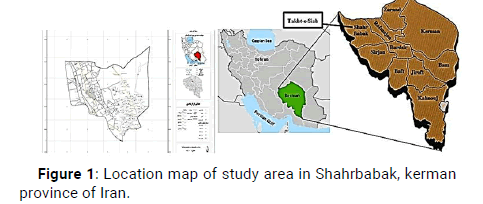
Figure 1: Location map of study area in Shahrbabak, kerman province of Iran.
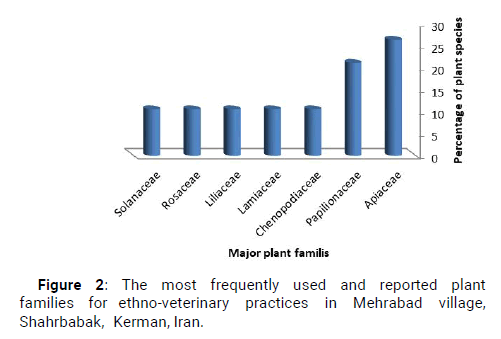
Figure 2: The most frequently used and reported plant families for ethno-veterinary practices in Mehrabad village, Shahrbabak, Kerman, Iran.
Sources and habit of medicinal plants
In the present survey, 72% of the reported species are the herb. Other highly reported species are the tree (11%) and the shrub (17%) (Figure 3). The common use of herbaceous plants was also reported in other parts of the world. Local people used herbs and trees most commonly as medicine due to the availability in surrounding area. The plant parts used by the local people to treat various ailments were mainly leaves, fruits, and seeds.
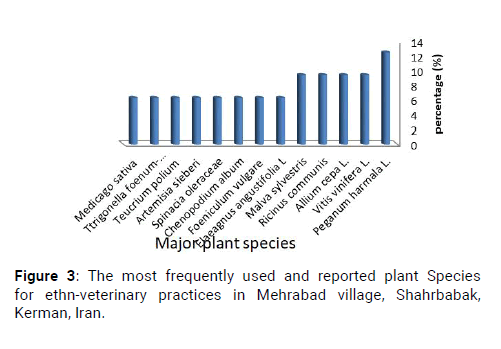
Figure 3: The most frequently used and reported plant Species for ethn-veterinary practices in Mehrabad village, Shahrbabak, Kerman, Iran.
Plant parts used to prepare remedies and route of administration
The most frequently utilized medicinal plant's parts were seeds (23%), leaves (20%), Aerial part (20%), fruit (15%), bulb and follower (5%), root, whole plants, bark and stem (each 3%) (Figure 4). A numerous techniques of preparation were employed before administering the remedies, while the leaves, roots, seeds, and barks of traditional medicinal plants are crushed/ chopped and squeezed and then filtrated to get the plant juice needed for oral drenching (65.79%), topical (18%), smoke (8%) and chew (8%) application (Figure 5). In most places, local communities, utilized for the preparation of herbal medicine using leaves.
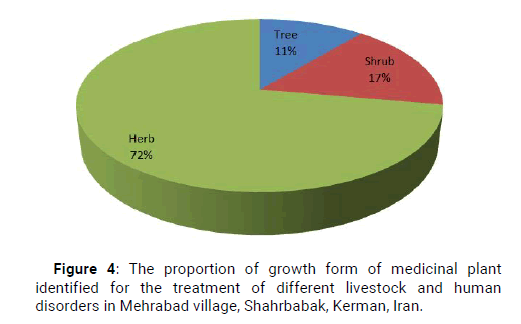
Figure 4: The proportion of growth form of medicinal plant identified for the treatment of different livestock and human disorders in Mehrabad village, Shahrbabak, Kerman, Iran.
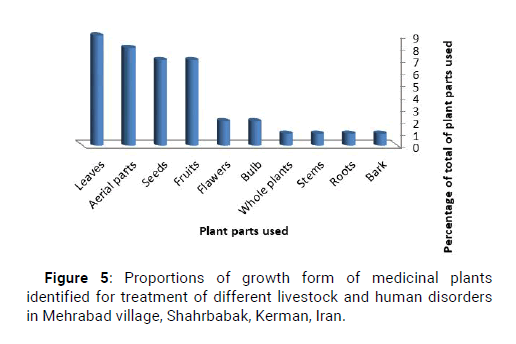
Figure 5: Proportions of growth form of medicinal plants identified for treatment of different livestock and human disorders in Mehrabad village, Shahrbabak, Kerman, Iran.
Medicinal indication of herbs (diseases treated by plant preparations)
Such wide harvesting of leaves and seeds compared to roots, barks and whole plants which are important for survival of plants has a less negative impact on the survival and continuity of useful medicinal plants and hence does not affect sustainable utilization of the plants, but in this study area the combine factors like the roots, barks and whole plants used for ethno-veterinary practice by the traditional healers and the residents also depend on medicinal plants for various purposes such as forage, firewood, spice, construction, agricultural expansion, and food they have the negative pressure on sustainability of the medicinal plants and climate change. The survey revealed that the major portion of the farmers in the villages relies on traditional veterinary knowledge, practices and locally available materials primarily medicinal plants to cure and prevent livestock health problems such as coughing, wound, diarrhea, external parasite, blood purifier, digestive problems, bloating, indigestion, internal parasite, gastric problem, laxative, urinary inflammation, antiseptic, bone fracture, mastitis, general, tonic, enhancement of lactation, rumen impaction, retained placenta, fever, urinary inflammation, cold and pain (Table 2). Although, other local materials are used, the use of plants for the treatment of various ailments prevails (Figure 6).
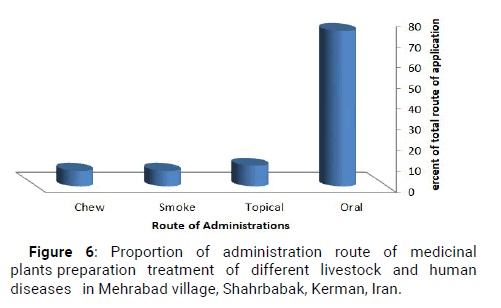
Figure 6: Proportion of administration route of medicinal plants preparation treatment of different livestock and human diseases in Mehrabad village, Shahrbabak, Kerman, Iran.
| Diseases treated | Number of ethno-veterinary medicinal plant remedies used |
|---|---|
| Coughing | 4 |
| Wound | 4 |
| diarrhea | 5 |
| External Parasite | 4 |
| blood purifier | 1 |
| Digestive problems | 4 |
| Bloating | 2 |
| Indigestion | 1 |
| Internal Parasite | 5 |
| gastric problem | 3 |
| Laxative | 1 |
| Urinary inflammation | 1 |
| Antiseptic | 3 |
| bone fracture | 1 |
| mastitis | 3 |
| General tonic | 1 |
| Enhancement of lactation | 2 |
| Rumen impaction | 7 |
| Retained placenta | 2 |
| Fever | 2 |
| Urinary inflammation | 1 |
| Cold | 2 |
| Pain | 1 |
Table 2: The number of ethno-veterinary medicinal plant remedies used to treat ailments/conditionsIn the study area.
The survey revealed the 37 plant species used in Ethnoveterinaryin the village of Mehrabad, some of them have been recorded in other parts of Iran,some of plants such as:
Chenopodium album L., Nicotiana tabacum L., Pistacia atlantica L., Ricinus communis L. , Triticum aestivum L. and Peganum harmala L. Used in the southern regions of Ilam province. The results of this study are proximally similar with results of the studies have done in southern regions of Ilam province. and Achillea wilhelmsii C.Koch., Cuminum cyminum L. , Glycerrhiza glabra L., Juglans regia L. Medicago sativa L. and Teucrium polium L. Used in the Kerman province [7]. Artemisia sieberi L., Vitis vinifera L. and Cassia fistula L. Used in the Fars Province. Peganum harmala L. Used in the North Khorasan Province. Some of results are the same as others research and some are different.
The same plants for the same ailment could be prepared in different ways, depending on the preferences of different healers For example in this study Dried leaves of Pistacia atlantica L. smoked (smoke bath) to treat Coughing but other studies showed that the leaves of P. atlantica L., can use orally for the treatment and alleviation of coughing in dogs. P. atlantica L. leaves contain secondary metabolites, especially flavonoids and tannins.
Our study has showed that fruits of Foeniculum vulgare Miller. Use to treat gastric problem and diarrhea. Have reported was used to treat digestive problems such as diarrhea as a rumen mobilizer, and also to treat behavioral problems, aggressiveness, and parasitic diseases in Turkey. Were reported the aerial parts of F.vulgare Miller use for digestive problems.
In this study, Chenopodium album L. is used to eliminate internal parasite, blood purifier and laxative. Similar results have been reported by Siliguri in India. Researchers have reported that C. album L. is used to heal wounds and bloating in Pakistan. A study by Yibrah Tekle in Ethiopia showed that C. album L. is used to treat abdominal pain, abdominal swelling and internal parasites.
Ricinus communis L. seed oil is laxative. It has similar uses in traditional veterinary medicine. In Mehrabad village castor oil used to treat digestive problems and Rumen impaction of their livestock. Also in Hassan District of Karnataka, India R. communis L. seed oil is orally administered to constipation. The fresh/dried fruit of this plant in Eastern Ethiopia is used to treat Blackleg and Actinomycosis and also Mange [12]. R. communis L. powder of the seed is used for sterility in horse and donkey in district Karak, Pakistan. In southern Ethiopia, fresh leaves of castor are mixed with water and used orally to treat mastitis and poor mothering.
Triticum aestivum L. Seed is primarily used as a concentrated source of nutrients. It contains ample load of vitamin A, vitamin C, and vitamin E, iron, calcium, magnesium, and amino acids. In district Bhiwani (Haryana) India this seed are crushed and mixed with tea leaves and Ashwagandha, the mixture is given to camel to treat cold. T. aestivum L. Seeds are roasted is used to increase lactation among the people of Mehrabad Shahrbabak region.
In this study, Juglans regia L. Leaves are boiled in water and filtered then it used orally. For the treatment of external parasites but in another study in Pakistan have previously reported that fresh leaves of J. regia L. are eaten by the animal for relieving the gastric problems and for the retention of placenta.
Mentha longifolia L. is a plant with many properties. Various pharmacological activities have been confirmed for M. longifolia L., such as anti-parasitic, anti-microbial, anti-insect, anti-mutagenic, anti-nociceptive, anti-inflammatory, antioxidant, kerato protective, hepato protective, anti-diarrhea, and spasmolytic effects.
Phytochemical compounds of M. longifolia L. are Flavonoid, alkaloid, cardiac glycoside, terpenes. In Mehrabad village Shahrbabak, Fresh or dried leaves of M. longfolia L. is given orally to Digestive problems.
In Ethnoveterinary health there are many reports about the properties of Allium sativum L. and Allium cepa L. in Mehrabad village Shahrbabak, A.cepa L. Crushed Bulb mixed with water and given orally for Coughing. Bulbs are consumed chewable to Bloating. In Hassan District of Karnataka, India reported to be useful for A. cepa, Bulb is grind and mixed with black salt and used to drink with water to cure infection of mouth and hoops. In South Waziristan agency and Bajaur agency, Pakistan A. cepa L. Bulb are given orally to cow, sheep, buffalo and goat to treat digestive problems. It is administered orally for 4–5 days or spread on the body part in Stomach disorder, fever, Skin infections Researchers of Ethnoveterinary health in South Asia use root of A. cepa L. to treat infertility and bronchitis. It has been investigated that the biological activities of onions are mainly due to the volatile compounds of sulfur in it.
The people of this area are squashed and filtered A. sativum L. Bulb and given orally to treat internal parasite. Manoranjotham and Kamaraj use garlic for Skin disease. In another report Root Powder of A. sativum L. Orally given to animals, i.e., goat, sheep, for infection treatment. Bulb is crushed and mixed with way to administered orally in order to rate of fertility in domestic animals. These researchers use the garlic orally to treat mastitis and cough and in other reports A. sativum L. use for Witching, shivering, breathlessness, parasites, poison, heat, fever, colds, diarrhea and Blackleg.
Dried aerial parts of Malva sylvestris L. is used to treat stomach fever, coughing and cold in sheep and goats in Mehrabad village Shahrbabak, others studies have showed crushed leaves are given to cows for increase milk production and water decoction of M. sylvestris L, was filtered and offered as drink.
In this study, Olea europaea L. Fruits oil is orally administered to treat Rumen impaction and in another study Zeytoon Oil (O. europaea L.) orally used for many properties such as: Anti inflammatory, broken bones tonic. The oil is used topically for inflammation and broken bones are also emulsified by the oil. This oil is used orally as general body tonic.
Opium is the Latex of the poppy (Papaver somniferum L.) Plant. Opium contains many alkaloids, including morphine, modoin, codeine, thebaine, papaverine and noscapine. Opium (P. somniferum L. Latex) is one of the most valuable drugs, Morphine and Codeine, the two principal alkaloids, being largely used in medicine. The most important application of papaver alkaloids is due to their analgesic properties. In this study, opium (P. somniferum L. Latex) mixed with little water and applied topically to treat mastitis. Others have reported the use of this latex as analgesic. In Peshawar, Pakistan, fruit of the poppy (P.somniferum L.) Plant is used in the manufacture of a combination medicine to treat vaginal prolapse.
In this study and another study in India Zea mays L. Decoction of the female inflorescence is orally administered to cure urinary inflammation. But locals in Yunnan, China, use corn Seeds to treat wounds.
In this study Dried Seeds of Solanum nigrum L., are boiled in water and given orally to Fever, Coughing, cold. The People in Siliguri Subdivision of Darjeeling District, West Bengal, India They also have a similar use (Fever, cough and cold, acidity).
In Mehrabad village Shahrbabak, dried Leaves of Nicotiana tabacum L. mixed with water and filtered then given orally to treat internal parasites and dried Leaves mixed with water and Is poured on the back of the sheep to treat external parasite and similarly, N. tabacum L. is used topically for the external parasite treatment and used as anti-parasitic. Species of Vitis vinifera L. Indicated as a remedy for different ailments in all categories (ectoand endo-parasites, gastrointestinal diseases, viral and bacterial diseases, wounds, sprains and bruises). Whereas in Mehrabad village the decoction of fruit was used against bloating and rumen impaction.
In the present research the smock of Peganum harmala L. seeds are used to treatment mastitis, external parasite, Wound and pain. Smock of P. harmala L. seeds used for killing of pathogen, healing of wound and reduce pain in district Karak, Pakistan. In South Waziristan Agency and Bajaur Agency Pakistan, P. harmala L. Whole plant used orally and topically to gastro intestinal problems anti parasitic, skin diseases, goat. In Thakht-e-Sulaiman hills, West Pakistan P. harmala L. mange against ectoparasites and for body cooling in North Khorasan Province Iran, P. harmala L. Whole plant for the Theileriosis and mastitis treatment.
In this study, 37 species which belongs to 25 families of ethnoveterinary medicinal plants were identified in the study area. The result of this study is agreed with the all above citation and documentation. The distribution of healers indicated that, of the 11 traditional livestock practitioners interviewed, majority were in the range of 60-85 years of age. Majority of informants accounting for 70.7% were males, and the remaining 27.3% were females.
It is observed that the knowledge regarding ethno-veterinary medicine is still surviving among the elderly members of the rural communities in the district. However, modern medical healthcare especially, the veterinary section in developing areas is reducing t he use of medicinal plants for the treatment of livestock, and therefore, the practice of traditional knowledge for curing animal ailments is diminishing. Another is that this knowledge is not limited to medicinal plants it also includes many minerals and animal products such as white alum, animal oil, turtle eggs, etc. There is room for research in this area.
The authors thanks the Vice Chancellor for Research and Technology of Kerman University of Medical Sciences for accepting the cost of the above research project The authors express their sincere thanks to the local people of the study area for providing valuable information about plants used in veterinary medicine.
Citation: Meymand ZM, et al. "Study of Local Indigenous Knowledge of the use of Medicinal Plants in Traditional Veterinary (Ethno veterinary) in Mehrabad Village, Shahrbabak City of Kerman Providence, Iran". J Biol Todays World, 2022, 11(4), 1-9.
Received: 12-Apr-2022, Manuscript No. JBTW-22-60464; Editor assigned: 14-Apr-2022, Pre QC No. JBTW-22-60464(PQ); Reviewed: 28-Apr-2022, QC No. JBTW-22-60464; Revised: 13-Jun-2022, Manuscript No. JBTW-22-60464(R); Published: 20-Jun-2022, DOI: DOI: 10.4172/2322-3308.11.4.008
Copyright: © 2022 Abadi NH, et al. This is an open-access article distributed under the terms of the Creative Commons Attribution License, which permits unrestricted use, distribution, and reproduction in any medium, provided the original author and source are credited.